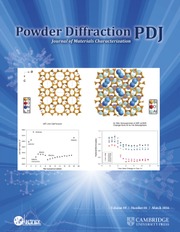Crossref Citations
This article has been cited by the following publications. This list is generated based on data provided by
Crossref.
Patterson, Brian M.
and
Hamilton, Christopher E.
2010.
Dimensional Standard for Micro X-ray Computed Tomography.
Analytical Chemistry,
Vol. 82,
Issue. 20,
p.
8537.
Wiederkehr, T.
Klusemann, B.
Gies, D.
Müller, H.
and
Svendsen, B.
2010.
An image morphing method for 3D reconstruction and FE-analysis of pore networks in thermal spray coatings.
Computational Materials Science,
Vol. 47,
Issue. 4,
p.
881.
2017.
Rock Physics II Complete Session.
p.
3771.
Voltolini, Marco
Haboub, Abdelmoula
Dou, Shan
Kwon, Tae-Hyuk
MacDowell, Alastair A.
Parkinson, Dilworth Y.
and
Ajo-Franklin, Jonathan
2017.
The emerging role of 4D synchrotron X-ray micro-tomography for climate and fossil energy studies: five experiments showing the present capabilities at beamline 8.3.2 at the Advanced Light Source.
Journal of Synchrotron Radiation,
Vol. 24,
Issue. 6,
p.
1237.
Xu, Ye
Li, Qiuzi
and
King, Hubert E.
2017.
Modeling Oil Recovery for Mixed Macro- and Micro-Pore Carbonate Grainstones.
Scientific Reports,
Vol. 7,
Issue. 1,
Baus, S S
Redko, L A
and
Yanushevskaya, M N
2017.
X-ray Tomographic System Behavior Prediction Based on a Mathematical Model.
IOP Conference Series: Materials Science and Engineering,
Vol. 189,
Issue. ,
p.
012016.
Goldfarb, Eric
Ikeda, Ken
and
Tisato, Nicola
2017.
Segmentationless digital rock physics using different effective medium theories.
p.
3908.
Plotnikova, I V
Chicherina, N V
Bays, S S
Bildanov, R G
and
Stary, O
2018.
The selection criteria elements of X-ray optics system.
IOP Conference Series: Materials Science and Engineering,
Vol. 289,
Issue. ,
p.
012029.
Ferguen, N.
Mebdoua-Lahmar, Y.
Lahmar, H.
Leclerc, W.
and
Guessasma, M.
2019.
DEM model for simulation of crack propagation in plasma-sprayed alumina coatings.
Surface and Coatings Technology,
Vol. 371,
Issue. ,
p.
287.
Goldfarb, Eric J.
Tisato, Nicola
Ikeda, Ken
Kerans, Charles
Ketcham, Richard A.
Gomez, Kiara
and
Boone, John M.
2019.
Numerically estimating rock frame properties of a mixed calcite and dolomite hand sample using computed tomography (CT).
p.
3558.
Cordes, Nikolaus
Kane, Joshua
and
Craft, Aaron
2020.
3D X-ray Microscopy of Nuclear Energy Materials.
Microscopy and Microanalysis,
Vol. 26,
Issue. S2,
p.
872.
Ikeda, Ken
Goldfarb, Eric J.
and
Tisato, Nicola
2020.
Calculating Effective Elastic Properties of Berea Sandstone Using the Segmentation‐Less Method Without Targets.
Journal of Geophysical Research: Solid Earth,
Vol. 125,
Issue. 6,
Ikeda, Ken
Subramaniyan, Shankar
Quintal, Beatriz
Goldfarb, Eric James
Saenger, Erik H.
and
Tisato, Nicola
2021.
Low-Frequency Elastic Properties of a Polymineralic Carbonate: Laboratory Measurement and Digital Rock Physics.
Frontiers in Earth Science,
Vol. 9,
Issue. ,
Cordes, Nikolaus
Sudderth, Laura
Butt, Moiz
Jewell, James
Meyer, Mitchell
and
McDeavitt, Sean
2021.
Laboratory-based 3D X-ray microscopy of unirradiated U-10Zr fuel.
Microscopy and Microanalysis,
Vol. 27,
Issue. S1,
p.
1938.

